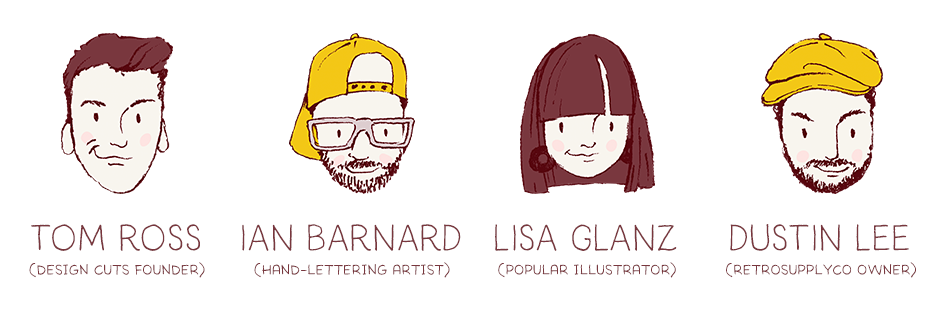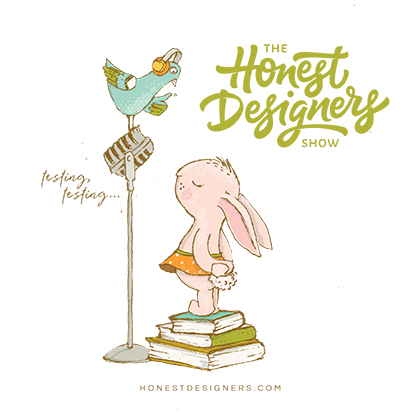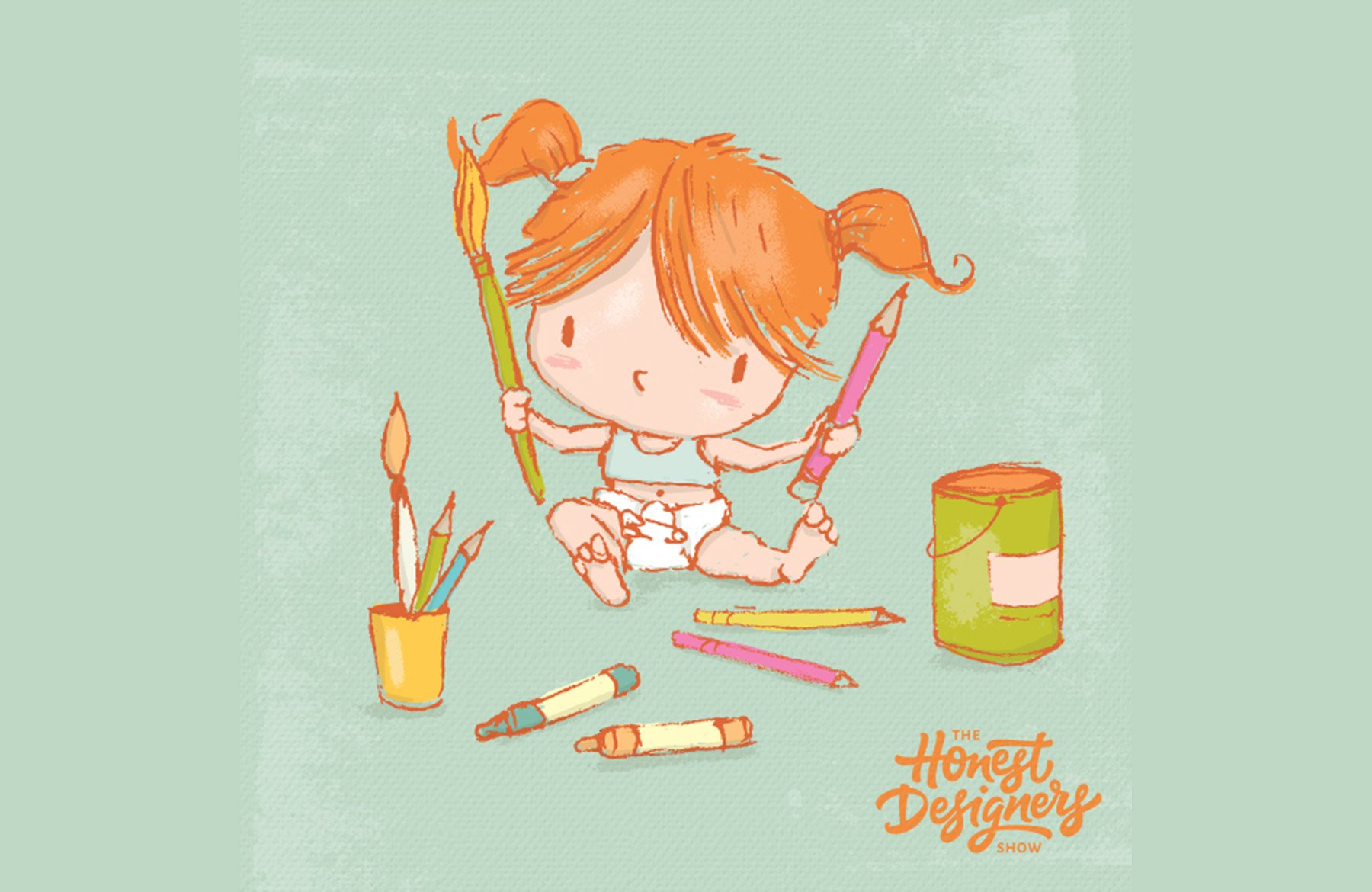In this week’s episode we answer some listeners questions and cover a range of issues, everything from how to avoid compromising your morals during a design project to how to price yourself competitively and how to organise your projects better.
[smart_podcast_player]
Other Ways to Listen: Soundcloud | iTunes | Stitcher
Meet Your Hosts
The Honest Designers Show started when our founder Tom found he was regularly chatting and sharing tips with top designers; Ian Barnard, Lisa Glanz and Dustin Lee. We soon organised a weekly call where we would help each other with areas we were struggling with and try to give each other actionable feedback. Soon we realised that the collective experience of the group was proving so valuable for each of us, that we thought ‘why not share these conversations with the world?’.
And so, The Honest Designers Show was born! This podcast is an insight into how to succeed in the creative industry, as well as giving you a totally transparent, under the hood look at some of the tougher, less glamorous hurdles to overcome! We also tend to get a little goofy along the way, so this is a chance to get to know each of us a little better :). We’ve loved recording this show for you, and we hope that you find value and enjoyment in listening to it.
SHOW NOTES
Please find full show notes for this episode below:
[1:00] This week we’re back with another round of listener’s questions
[1:30] First question is from calligrapher David @masgrimes and his questions is: do you sacrifice your beliefs to get involved with projects that might promote things that are in conflict with what you believe, for either money or exposure?
[3:00] Lisa strongly believes that you shouldn’t compromise your beliefs as there is a reason why your beliefs are what they are
[3:40] She was in the position where she was asked to do a brochure for canned lion hunting and it was an absolute no from her
[5:20] The hosts strongly agree with Lisa’s decision and say that they would have also refused to work on this project
[5:40] Dustin’s terms on the website specify that the products can’t be used for pornography
[6:00] He was also asked to do something for cigarettes and he asked himself if he want to earn money from something that promotes cigarettes and decided not to do it
[6:30] Ian was asked to do a design for a sex toy shop website and decided that this was something he didn’t want to do
[7:50] There are different levels of what people don’t feel comfortable with
[8:30] While doing freelance work, Tom only accepted projects that inspired him and he was excited to work on
[9:20] The hosts agree and say you shouldn’t compromise your beliefs for working on a project
[9:50] Even if you need the money, don’t do it, as you will look back and later regret your decision
[10:40] Be sure that any company you associate your work with, won’t affect your brand name on the long term
[11:15] Dustin asks the hosts how do they feel about political situations in which the audience is split in half, do you associate yourself with one side
[12:45] Lisa suggestion is not to choose any side, but to do the morally right thing
[13:20] Ian agrees with Lisa and tries not to choose a side to be affiliated with
[15:00] Some might think differently and will have strong political views and this will feel right as they will continue to be true to themselves
[15:40] Your name is not always tied to your work, so if you truly need the money do that and don’t include the work in your portfolio
[16:30] Ian says that he wouldn’t do the work, even if other people won’t find out, as this won’t sit well with him
[17:10] But agrees he will do things that are maybe a bit more girly and would not promote these in his portfolio
[17:50] Dustin says that there is more to this question, but thinks that the general rule is to respect each other’s feelings and freedom to express themselves
[18:40] Second question is from Sierra – she does illustration, calligraphy and lettering and you can see her work @sidesignloft on Instagram. Her question is: how do you price your work competitively without pricing too low?
[20:00] Lisa speaks from her own experience and says she didn’t want to put cheap and work which wasn’t great, but instead went for quality and a bit more expensive designs
[20:30] She admits that this has turned some clients away
[21:00] Lisa’s advice to Sierra is to think where she wants to position herself in the industry
[21:40] Tom’s suggestion is to price yourself competitively
[22:30] When pricing too low you always need to consider that there’s always going to be someone pricing lower than you
[23:00] It’s okay to undercut your competitors if it gets the ball rolling
[23:20] Most important is to think how you can increase the value you give your clients, improve your skill set and make you a more valuable asset to hire
[24:00] Ian recommends The Graphic Artists’ Guild Handbook of Pricing and Ethical Guidelines book and says it’s a good resource to explain how you’ve priced yourself
[25:00] He recently had to tweak one of his fonts and found the book useful to know how to price this type of work
[25:50] He sais he would rather price himself higher and do less jobs that are better paid than many smaller jobs
[26:40] A serious client will either have a set budget in mind or they will negotiate with you on price
[27:00] Pricing needs to be fluid and there isn’t a ‘one size fits all’ situation
[27:30] Consider all aspects of dealing with an individual vs. working with a bigger corporation
[28:00] Tom is uncomfortable to reveal his budget as he thinks this puts the designer in control
[29:00] Dustin agrees and he would rather know the cost of the work up front
[30:00] Ian reveals he sometimes uses the available budget option
[30:30] Showing a base price is very helpful for the client as they will know what to expect for their available budget
[31:00] Lisa provides her clients with a price range
[31:40] Pricing shouldn’t be a race to the bottom – you should respect your work and your time and in return respect you client’s money and give them a good service
[32:40] Tom reveals he would like to test some companies who are not transparent on pricing by sending them emails pretending to be a small client vs. a big corporation and find their asking price for each
[33:50] Lisa says she sometimes is willing to drop the price, work with the client’s budget and explain to them that they won’t be getting the full package
[34:30] Dustin reveals he would drop the price for a big corporation if it could potentially bring more customers in the long term
[35:30] There’s more that needs to be considered than just the finances
[36:00] Dustin gives James Altucher’s example on how he did lots of websites for famous movies for a very low price and created a great portfolio for himself
[36:40] Lisa thinks that having big clients names in your portfolio might scare some smaller clients away
[37:00] Tom talks about some campuses initial resistance to Facebook
[38:00] The final question is from Rebekah @bekah_isaiah53design and she asks how to organise her files as a new designer and how to organise each project?
[39:30] Lisa says she even ended up a double of a product as she couldn’t keep track of the files she had
[40:00] She has started a system of tracking old client files by opening a job ticket for each client and attributing a number to the job ticket
[40:50] Ian had a similar way of tracking files at his old job but admits that he is not as good at organising his client’s files now
[41:50] The host admit they’re all guilty of giving their files very generic and similar names and struggling later to find the right one
[42:40] Lisa uses a links file to find her projects
[43:40] When the work is completed and gone to print, Ian will create a final package in Id with all the client’s assets
[44:00] Tom mentions a lot of people use Adobe Bridge to organise their files but the hosts reveal they weren’t so keen on this due the program’s pop-up option
[45:00] There are however many people who are using this software and find it very useful
[45:30] Tom used a folder for Materials, one for Mood Boards, WIP and a final folder with Deliverable for clients
[46:00] Lisa recommends including the job number on the client’s invoice so that when they need something you can find it easier using the tracking number
[47:00] She also used to add the job numbers on the actual project files
[48:00] For storage Tom recommends using a cloud service as he doesn’t like the idea of external drives
[48:40] Dustin says he uses the Dropbox Premium on which he periodically updates his files
[50:00] Dustin mentions DaisyDisk – a software which analyses your disk storage and frees up disk space on your computer
[51:00] The hosts have received a lot of listeners questions so they plan to have a new episode soon to discuss these
[52:00] Thanks you so much for listening to this week’s episode
How you can help
As this is a new show, we’d really appreciate your help spreading the word. If you enjoyed listening and found value in this episode, you can do these two things to help us:
1. Subscribe to The Honest Designers Show in iTunes
2. Leave us an honest rating/review in iTunes
Early reviews can make the world of difference for new podcasts being discovered, and it would mean the world to us if you were able to help.
Click to listen to The Honest Designers Show on iTunes
Here is a quick guide for how to leave a review on iTunes
Want Help From the Honest Designers?
We would love to help you with your creative journey! Simply use #honestdesigners on social media, and the four of us would love to check out what you’re working on, join the discussion and try to help wherever we can!
Join the discussion on Instagram
Join the discussion on Twitter
Let Us Know What You Think
We would absolutely love to know how you enjoyed this episode. We’ll be releasing a new episode each Wednesday, and look forward to hopefully answering many of your questions on the show.






Just listened to this podcast today.
Re: Morals and dealing with politics
At the risk of choosing sides, it’s difficult to propose conservative based designs in a liberal dominated design world. So looking at designs produced by philosophically different artists and trying to ascertain their good traits are hard to separate.
Hey Anne, thank you so much for your comment. I am so happy to hear that you’ve enjoyed this episode and that you’ve found Lisa’s way of organising files useful. Your suggestion of naming the files is great and I will pass this over to our hosts.
Thanks for letting us know that you’re also finding organising your resources challenging and we can definitely help you with this one. We get asked this question quite often, and we have a some information on this, so I will send you this over an email as it is quite lengthy message. Thank you ?
Can you also send me the email? Please and thank you ;)
Hi Julie, I’ve just sent you the email with more information on this topic now :)
Loved the latest podcast guys. Thanks so much. I just wanted to say I loved Lisa’s system of file management, it makes so much sense, but two comments on the same topic. 1) Ummm, why don’t you just date your files? Sorry It seems so obvious to me, I feel stupid asking, and maybe I’m missing something. I have always done this ( i.e. FileName_11Oct2017.psd) and even adding time if several versions sent off in same day (File_11Oct2017_1123pm.psd). 2) You mentioned briefly about organizing vast resources (and Lisa like me mentioned almost buying something a second time), and thanks to DC this has become more and more of a challenge for me. Could you offer up an organizational scheme for this? And maybe have a guest from DC if they’re better equipped to explain. Thanks in advance and can’t wait for more great advice from all of you.
Wow, thank you so much for answering my question! And yes, I would love to hear about project management and tools you use. I also loved the other two questions and your answers. I loved what Dustin said about not doing anything he’d not want to tell his children about. Thanks to each of you for all you do for the rest of us! God bless you richly! :)
Hey Rebekah, you’re so very welcome and I’m so happy that you’ve enjoyed the other questions too and found the answers useful. I will let the hosts know that you’ll be interested in an episode covering project management and tools. Thank you for the lovely wishes! ?
I heartily second that request for a Project Management episode!!
I will be the first to admit that Bridge isn’t perfect but its’ benefits far outweigh the less than 15 seconds of time that it takes to change or remove a keyboard shortcut so that Bridge doesn’t open ;)
P.S. In addition to InDesign, File > Package is available in Photoshop, Illustrator, CC for Teams, Premiere Pro (via Project Manager), etc.
Hey Julie, thanks so much for listening to the Honest Designers podcast and for sharing this very useful information. I’ve already passed this info to our hosts ?